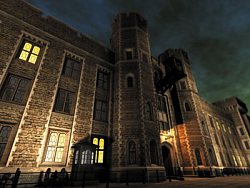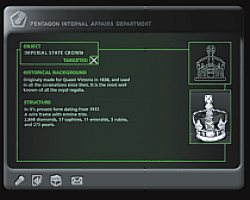| Graphics - Presentation The graphics actually are very good. Nothing world-moving, but for a
3D-graphic really quite acceptable. Like in the most better games, perspective and
distortion is considered and through this you get a really good impression. I positively
noticed the wealth of details. Not as much as in graphical masterpieces like Atlantis 2 or
Amerzone, but over the average. The walls partly consist of old, rough bricks, the doors
are rusty, wood has a beautiful structure ...
Basically everything is arranged rather dark, for it's night.
You are playing from the view of Raven, and only during the video sequences you can see
Raven from the "outside". The few characters are not as well designed as the
remaining graphics. But as you seldom meet other persons, this fact isn't really
disturbing.
Story
The story itself, the mission and this technical
stuff was not so much my kind of thing actually. I also found it a bit illogical up to a
certain degree. When Pentagon and the President know about all, why they just do not let
one of the guards exchange the crown jewels? Why does a secret breaking-in must take
place? No, I think this is a bit far away.
Puzzles
The puzzles weren't bad at all but rather difficult.
Just at the beginning you could get stuck if you hadn't
listen carefully during the mission briefing, because one agent's name is the password for
the PDA, and without that it's impossible to go on.
Most of the time you have to use objects, e. g. open a door
with a code-card, blow up a wall, etc.. If you don't possess this technical kind of
thinking here, you will have some problems to go on.
Again and again I tried everything and every object to reach
my aim. I also often wasn't quite sure, if my way of solution was basically false, or if I
only missed my mark for a second. I think, it would have been quite meaningful, if Raven
from time to time would have had "thoughts" so that one would have got hints,
because the difficulty level was, for me at least, quite high.
Another important element of the game was to discover secret
hiding places of keys, codes etc.. Therefore you had to photograph and let analyse a lot.
A lot of boards and objects, you can easily get confused or forget something apparently
unimportant or delete important emails.
Traitor’s Gate is also difficult, because it's
non-linear and there is no given way but only a basic structure: 1. get mission equipment,
2. get around the security systems, 3. exchange crown jewels, 4. give original crown
jewels to your "Traitor’s Gate"-colleagues.
The pleasant freedom of movement can also be a kind of a
problem when you lose orientation. I had this kind of problems I must confess and I always
had to realize what I had, where I was and where I wanted to go. Some comments of Raven
would have helped here a lot, e. g. that you only can leave a building when you've found
all important objects or codes.
Result: Quite a nice game, if you like
espionage- and burglar stories, with a relatively high difficulty level and some walking
around without orientation.
Pro:
- 360° Panorama
- much freedom of choice
- very good graphics
Contra:
- difficult puzzles (complicated logic)
- long loading times
- disorientation
- complicated e-Mail-administration
My overall-rating: 63%
Rating system:
- 80% - 100% excellent game, very recommandable
- 70% - 79% good game, recommandable
- 60% - 69% satisfactory, restricted
recommendable
- 50% - 59% sufficient (not very
recommendable)
- 40% - 49% rather deficient (not to be
recommended - for Hardcore-Adventure-Freaks and collectors only)
- 0% - 39% worst (don't put your
fingers on it)
Minimum system requirements:Windows 95/98
Pentium 100
32 MB RAM
150 MB free hard disk space
8x CD-ROM-drive
Graphic Card with 1MB RAM
Sound Card
Played on:
- Windows 98
- Pentium II
- 129 MB RAM
- LITEON CD-ROM LTN362
- NVidia RIVA 128/128ZX
- Sound Blaster AudioPCI 64V
|
 Traitor's
Gate
Traitor's
Gate 


